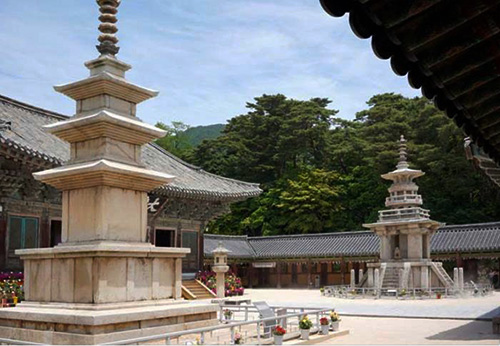
さて先日は韓国仏国寺での多宝塔と法隆寺の五重塔の対比を観ました。
日本では石仏は一般的にはお地蔵さんなどはあっても、
お寺の重要施設としてはあまり多くはありませんね。
木彫りの像というのが多いのだと思います。
石仏文化というものが日本ではあまり発展しなかったと言われますね。
さて、なぜなんでしょうか?
で、韓国では新羅時代など石工技術が隆盛したといわれる。
〜釈迦塔は法華経を説く釈迦如来を、多宝塔は釈迦如来の説法が真理であることを
過去仏の多宝如来が証明するという経典の内容を表現している。
単調だが完璧な均衡の美を有する釈迦塔と、七宝で飾られた華やかな多宝塔は、
新羅の優れた石工技術を示すもので、釈迦塔の二層目から見つかった
無垢浄光大陀羅尼経は、世界最古の木版印刷物である。〜という説明。
この石工の宝塔2基は仏国寺創建の750年頃のものと思われる。
この時代前後の日本での石工技術と言えば飛鳥の石舞台が相当するかと思えます。


この石舞台の創建は蘇我氏の未完成古墳という説があります。
石で組み上げられた玄室というイメージで
この主室を覆いつくすように土で被覆されれば古墳になったけれど、
ある政治的変動があってその工事が中断されたという解説なのですが、
ありそうな話だとは思いますね。
実際にこの内部も入ることができてわたしも実体験できたのですが、
この説に同意できるなぁと強く思わされました。
石工技術と言うよりも、巨石文化の残滓のように思われる。
こまかく石を加工するという意識よりも
土木工事の重要部分として巨石を利用するという社会的志向性。
で、こうした技術は日本ではその後城郭建築へと発展したのだと思います。
巨石を組み上げた石垣ではその巨石を運搬するのに
修羅といわれる大量人力による運搬が使われたことでしょう。
日本では石工技術はそういった方向に発展していって
上の韓国・仏国寺のような細かな石工技術には向かわなかったように思う。
石工というのはそれこそ石器時代からの技術体系のように思うけれど
日本列島に人間が暮らすようになった3万年前、あるいは縄文的定住が始まった
1万数千年前からでは列島には巨木の森が広がっていて
石に比べてはるかに加工しやすい木工技術の方が発展動機が高かったのではないか。
仏像や宗教的造作物でも木彫刻の方がより繊細な表現も可能。
韓国ではこうした繊細な宗教概念を石工で作り、ながく尊崇してきたということが、
ある種、異文化性として強く感じさせられました。
English version⬇
[Silla country masonry technology, 2 treasure towers Horyuji Temple and Bulguksa Temple-5]
By the way, the other day, I saw the contrast between the Tahoto at Bulguksa Temple in Korea and the five-storied pagoda at Horyuji Temple.
In Japan, stone Buddha generally has Jizo, etc.
There are not many important facilities in the temple.
I think there are many wood carving statues.
It is said that the stone Buddha culture did not develop much in Japan.
Well, why? Twice
So, it is said that masonry technology flourished in Korea during the Silla era.
~ Shaka Nyorai preaches the Lotus Sutra, and Tahoto says that Shaka Nyorai’s preaching is the truth.
It expresses the contents of the scripture that the past Buddha’s Prabhutaratna proves.
The monotonous but perfectly balanced beauty of the Shaka Tower and the gorgeous Tahoto decorated with cloisonne
It shows Silla’s excellent masonry technique and was found in the second layer of the Buddha Tower.
Innocent Joko Daidharani Sutra is the oldest woodblock print in the world. Explanation of.
These two masonry treasure towers are believed to date from the founding of Bulguksa Temple around 750.
Speaking of masonry technology in Japan around this time, it seems that Asuka’s stone stage is equivalent.
There is a theory that the construction of this stone stage is an unfinished tumulus of Mr. Soga.
With the image of a stone-built chamber
If it was covered with soil so as to cover this main room, it would have become an old burial mound,
The explanation is that the construction was interrupted due to some political change.
I think it’s a likely story.
I was able to actually enter this inside and I was able to actually experience it,
I strongly felt that I could agree with this theory.
It seems more like a remnant of megalithic culture than a masonry technique.
Rather than the consciousness of processing fine stones
Social orientation to use megaliths as an important part of civil engineering work.
So, I think that these technologies have since evolved into castle architecture in Japan.
To assemble the megaliths To carry the megaliths of the stone wall
It is probably that a large amount of human transportation called Shura was used.
Masonry technology is developing in that direction in Japan
I don’t think I was able to go for the detailed masonry techniques of Bulguksa Temple in South Korea.
I think that masonry is a technical system from the Stone Age.
30,000 years before humans began to live in the Japanese archipelago, or Jomon settlement began
From 10,000 years ago, there was a forest of giant trees on the archipelago.
The woodworking technology, which is much easier to process than stone, may have been more motivated to develop.
Even for Buddhist statues and religious artifacts, wood carving can be used for more delicate expressions.
The fact that Korea has created such a delicate religious concept with masonry and has long revered it.
It made me feel strongly as a kind of cross-culturality.
Posted on 9月 17th, 2021 by 三木 奎吾
Filed under: 住宅マーケティング, 海外住宅事情







コメントを投稿
「※誹謗中傷や、悪意のある書き込み、営利目的などのコメントを防ぐために、投稿された全てのコメントは一時的に保留されますのでご了承ください。」
You must be logged in to post a comment.